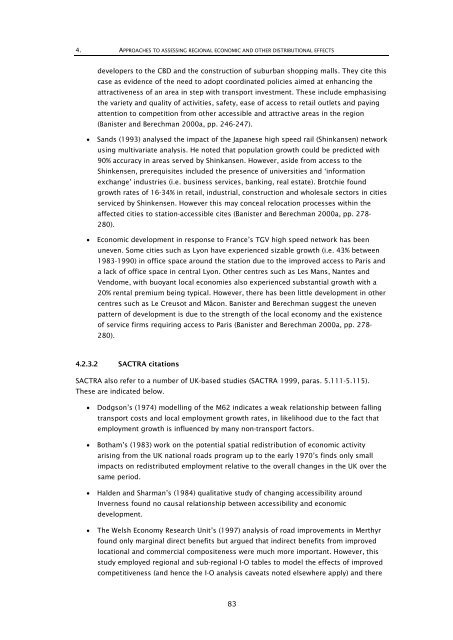Research 350 - NZ Transport Agency
Research 350 - NZ Transport Agency
Research 350 - NZ Transport Agency
You also want an ePaper? Increase the reach of your titles
YUMPU automatically turns print PDFs into web optimized ePapers that Google loves.
4. APPROACHES TO ASSESSING REGIONAL ECONOMIC AND OTHER DISTRIBUTIONAL EFFECTS<br />
developers to the CBD and the construction of suburban shopping malls. They cite this<br />
case as evidence of the need to adopt coordinated policies aimed at enhancing the<br />
attractiveness of an area in step with transport investment. These include emphasising<br />
the variety and quality of activities, safety, ease of access to retail outlets and paying<br />
attention to competition from other accessible and attractive areas in the region<br />
(Banister and Berechman 2000a, pp. 246-247).<br />
• Sands (1993) analysed the impact of the Japanese high speed rail (Shinkansen) network<br />
using multivariate analysis. He noted that population growth could be predicted with<br />
90% accuracy in areas served by Shinkansen. However, aside from access to the<br />
Shinkensen, prerequisites included the presence of universities and ‘information<br />
exchange’ industries (i.e. business services, banking, real estate). Brotchie found<br />
growth rates of 16-34% in retail, industrial, construction and wholesale sectors in cities<br />
serviced by Shinkensen. However this may conceal relocation processes within the<br />
affected cities to station-accessible cites (Banister and Berechman 2000a, pp. 278-<br />
280).<br />
• Economic development in response to France’s TGV high speed network has been<br />
uneven. Some cities such as Lyon have experienced sizable growth (i.e. 43% between<br />
1983-1990) in office space around the station due to the improved access to Paris and<br />
a lack of office space in central Lyon. Other centres such as Les Mans, Nantes and<br />
Vendome, with buoyant local economies also experienced substantial growth with a<br />
20% rental premium being typical. However, there has been little development in other<br />
centres such as Le Creusot and Mâcon. Banister and Berechman suggest the uneven<br />
pattern of development is due to the strength of the local economy and the existence<br />
of service firms requiring access to Paris (Banister and Berechman 2000a, pp. 278-<br />
280).<br />
4.2.3.2 SACTRA citations<br />
SACTRA also refer to a number of UK-based studies (SACTRA 1999, paras. 5.111-5.115).<br />
These are indicated below.<br />
• Dodgson’s (1974) modelling of the M62 indicates a weak relationship between falling<br />
transport costs and local employment growth rates, in likelihood due to the fact that<br />
employment growth is influenced by many non-transport factors.<br />
• Botham’s (1983) work on the potential spatial redistribution of economic activity<br />
arising from the UK national roads program up to the early 1970’s finds only small<br />
impacts on redistributed employment relative to the overall changes in the UK over the<br />
same period.<br />
• Halden and Sharman’s (1984) qualitative study of changing accessibility around<br />
Inverness found no causal relationship between accessibility and economic<br />
development.<br />
• The Welsh Economy <strong>Research</strong> Unit’s (1997) analysis of road improvements in Merthyr<br />
found only marginal direct benefits but argued that indirect benefits from improved<br />
locational and commercial compositeness were much more important. However, this<br />
study employed regional and sub-regional I-O tables to model the effects of improved<br />
competitiveness (and hence the I-O analysis caveats noted elsewhere apply) and there<br />
83
















